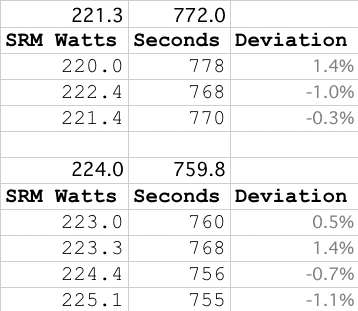SRM Power Meter Accuracy
Related: bicycle power meter, Road Bikes, SRM, training
SRM claims accuracy to within 2%.
Computing watts
Nominal power output can be computed with the following simplified formula, which does not take air resistance or drive-train losses or other power losses into account.
Watts = 9.8 * WeightInKg * AscentInMeters / seconds
or
Watts = 1.3549 * WeightInPounds * AscentInFeet / seconds
Naturally weight must be the total riding weight: rider + clothing, water, bike, etc.
Testing the accuracy
Consider the following efforts up my favorite Old La Honda climb. Ascents 1 and 2 were back to back on the same day, ascent 3 was the next day.
Total riding weight is approximate to within 1-2%. Nominal watts is computed as per the formula above. The SRM reading is about 16% higher than nominal computed watts, which seems reasonable when accounting for frictional and other forces.
| Ascent | Time mm:ss | Seconds | SRM watts | Nominal watts | Delta |
|---|---|---|---|---|---|
| 1 | 23:39 | 1419 | 287.7 | 247.8 | +16.1% |
| 2 | 22:40 | 1360 | 299.1 | 258.6 | +15.7% |
| 3 | 24:54 | 1494 | 267.1 | 237.7 | +12.4% |
Analysis: assuming the SRM power figure for Ascent 1 is accurate, Ascent 2 shows a reading that is 3.96% higher wattage, so we can expect a reduction to a time of 1365 seconds, which is within 5 seconds of the actual measured time, or within 0.3%.
On the next day, the power reading from Ascent 2 predicts a time of 1479 seconds versus a clocked time of 1494 seconds, or about a 1% difference. Being within 1% is still quite accurate, and this could be accounted for by inaccuracy in the total riding weight figure (I don’t have a scale available at the bottom of the hill).
Testing accuracy on a more gentle climb
This example is a 470-foot ascent taking just under 13 minutes in 2.04 miles.
Show below are two groups of ascents less than 24 hours apart. Deviation is calculated as the percent difference of the seconds/watts ratio versus the average seconds/average watts ratio.
As can be seen, the variation is at most 1.4%, well within the SRM claimed accuracy of 2%, and of course a bit of wind and fluid loss cannot be ruled out as at least minor factors.




